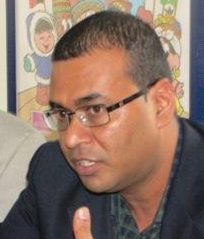While the local mining industry is both morally and legally bound to respect the rights and privileges of indigenous people in their own communities, the prevailing view in mining circles is that the authorities are advancing the issue of the rights of the country’s indigenous Amerindians as a means of enforcing its own agenda as far as mining in the country’s interior regions is concerned.
Guyana Gold and Diamond Miners Association (GGDMA) official Colin Sparman told Stabroek Business in a telephone interview on Tuesday that there was a clear case for miners to be aware of the impact of mining activities on the lives and livelihoods of Amerindian communities located in gold-bearing areas. “What is also true is that there are still several pockets of poverty in Amerindian communities and the question of those communities being able to benefit from the returns from the mining industry is certainly an issue that has to be dealt with.” However, according to Sparman the available evidence may well suggest that what is sometimes the official zealous articulation of what government claims is the exploitation of Amerindian communities and the despoiling of their living space is sometimes considerably overdone.

Robert Persaud
According to Sparman the notion that is sometimes peddled that Guyana’s Amerindian community is simply sitting by and allowing the ‘gold economy’ to pass them by is a farce that ignores the reality of the situation. “If you visit the mining areas of Guyana you quickly come to realize that there are areas of the country in which Amerindians are very much a part of the gold economy. There are areas of the Upper Mazaruni, for example, in which Amerin-dian miners operate dredges and where the paddle boat has been replaced by boats equipped with 15 horse power engines. Lifestyles are changing considerably and the construction that is taking place in those areas provides evidence of greater affluence. I would say that there are huge areas of the upper Mazaruni where Amerindians operate 80 per cent of the dredges, Sparman said. The GGDMA official told Stabroek Business that while more still had to be done to improve the lot of Amerindian communities, many Amerindians had used the mining industry as a means of working their way out of poverty.
And according to the GGDMA official while the mining sector had persistently declared its preparedness to work with the authorities to minimize environmental transgressions in the sector, the key to advancement of environmental standards lay in the enhancement of monitoring mechanisms. Noting that this was an official function Sparman said that much of the problem had to do with the inability of the authorities to implement strict and effective monitoring mechanisms. According to Sparman it was not a question of the absence of regulations but of an inability to enforce them. He said that enforcement problems may, to some extent, stem from problems associated with the preparedness of transgressors to offer inducements to inspecting officials to ensure that no penalty accrues for the transgression.
Meanwhile Sparman told Stabroek Business that the Association was of the view that the controversy over river bed mining was, in effect, much ado about mining since the practice occurs in a relatively small number of rivers “and again it is a question of ensuring that effective monitoring mechanisms are in place. Just weeks ago Natural Resources and Environment Minister Robert Persaud was quoted as saying that government has no intention of terminating river mining but will suspend the issuance of river mining permits for a one-month period in order to allow for an assessment of the impact of this form of mining on the communities using those rivers. However, according to Sparman, while representatives of the GGDMA and the GGMC have already met with the Minister and agreed to the establishment of a committee to review the impact of river mining, sections of the mining community are of the view that the government may be responsive to what he says is a strong lobby that might be coming from the Board of the GGMC to end river mining.





